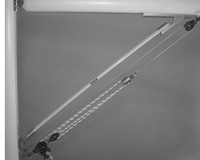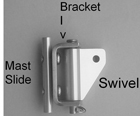Manufacturer part #: K1000
Boomkickers use two coated solid fiberglass spring rods to provide the force necessary to support the boom and mainsail. The rods are clamped into teflon anodized aluminum end pieces and attached to universal mast and boom fittings. Fittings are included along with machine screw fasteners, the proper drill and tap and hex wrench. The mast fitting includes a round slide which, used in the luff groove, avoids drilling into the mast. Flat slides in varying widths are available from the factory. The slides can often be inserted at the sail opening above the gooseneck and slid down reassembling the fitting in position. If slides are not usable, the fitting can be attached directly to the mast using the same drill and tap provided for the boom. The custom extruded boom track is contoured to fit both round and flat bottom booms. The track has an adjustable clevis pin to set the maximum height the Boomkicker will lift the boom. The track length forward of the pin allows the boom to move higher if needed.
| Boomkicker Model |
Suggested Boat Size |
Initial Pin to Pin |
Minimum Pin to Pin |
Maximum Force (1) |
Stroke | |
| Initial (2) | Min. (3) | |||||
| K0312 | 14 - 16" | 30" | 25" | 75 lbs | 11" | 6" |
| K0400 | 16 - 19" | 34" | 26" | 150 lbs | 11" | 6" |
| K0500 | 16 - 20" | 36" | 26" | 150 lbs | 11" | 6" |
| K0750 | 20 -25" | 36" | 31" | 250 lbs | 11" | 6" |
| K0800 | 25 - 27" | 45" | 35" | 30 lbs | 15" | 6" |
| K1000 | 27 - 30" | 45" | 41" | 400 lbs | 15" | 6" |
| K1250 | 30 - 34" | 53" | 43" | 500 lbs | 16" | 9" |
| K1500 | 34 - 38" | 53" | 49" | 600 lbs | 16" | 9" |
2. Maximum stroke at initial Pin to Pin
3. Maximum stroke at min. Pin to Pin. Stroke is travel when flexed. 1" of stroke equates to approximately 7" at the aft end of the boom.
* Uses webbing sling at boom instead of track fitting.
 Note: To avoid undue stress on the boom fitting, it's recommended that booms be fixed in the upright position. If the boom can roll about its' central axis, please contact the factory before installation.
Note: To avoid undue stress on the boom fitting, it's recommended that booms be fixed in the upright position. If the boom can roll about its' central axis, please contact the factory before installation. Recommended Installation Tools: Phillips Screwdriver; Fine Tooth Hacksaw; Center Punch; Rule; Variable Speed Reversible Drill and Blue Locktite.
1. Setup Boom Height: Use the main halyard to support the boom above its highest operating position, or a desired height when moored or docked. At this time, check that the Model K1000 is correct. The min. length is 40" (102cm) pin to pin and the max. weight it can support is approximately 34 lbs. (15kg) measured at the outboard end of the boom with the main sail flaked as stored.
2. Position Boomkicker: The Boomkicker works by flexing upward and when straight, it is at the top of its travel. Install the Boomkicker with the screw head side of rod clamps facing up to flex upward away from the vang. With the boom height set, position the Boomkicker with fittings alongside the vang triangle to see how it fits. Position is not critical so long as it does not interfere with the vang. It's recommended that both the vang and the Boomkicker make an angle of between 30o and 45o with the boom. Mark the location for the mast fitting.
 3. Install Mast Fitting: The mast fitting comes with a luff grove slide to avoid drilling the mast. Different diameters and flat slides are available by exchange, or at the web site or by phone. See part list. If usable, after disassembly from the fitting, the slide can often be inserted at the mast opening for the sail and dropped or lowered with a string. If the mast is out of the boat, the slide may be inserted from the base of the mast. Reassemble the mast fitting at the desired location and tighten the screws. If the slide is unusable, the bracket may be screwed directly to the mast. Extra long screws are included if needed to pass through the groove. Use the #7 drill and the 1/4-20 tap provided, with the mast fitting bracket as a guide. A variable speed, reversible drill makes tapping easy. Go slow. Locktite is recommended on threads.
3. Install Mast Fitting: The mast fitting comes with a luff grove slide to avoid drilling the mast. Different diameters and flat slides are available by exchange, or at the web site or by phone. See part list. If usable, after disassembly from the fitting, the slide can often be inserted at the mast opening for the sail and dropped or lowered with a string. If the mast is out of the boat, the slide may be inserted from the base of the mast. Reassemble the mast fitting at the desired location and tighten the screws. If the slide is unusable, the bracket may be screwed directly to the mast. Extra long screws are included if needed to pass through the groove. Use the #7 drill and the 1/4-20 tap provided, with the mast fitting bracket as a guide. A variable speed, reversible drill makes tapping easy. Go slow. Locktite is recommended on threads.  4. Shorten if Necessary: If the Boomkicker is too long, we recommend shortening the rods at the mast end so any cut ends are less visible. Loosen the rod clamp with the provided hex-key and slide the extension up the rods until there is a good fit. The bottom half of the clamp fittings for each extension have embossed stops to prevent slipping. Do not shorten total length more than 5" (12.5cm). Cut off extra rod length equally from both rods with a fine tooth hacksaw. Before tightening the clamps, check the rod ends are against the embossed stops and the clamps/extensions are not twisted relative to each other.
4. Shorten if Necessary: If the Boomkicker is too long, we recommend shortening the rods at the mast end so any cut ends are less visible. Loosen the rod clamp with the provided hex-key and slide the extension up the rods until there is a good fit. The bottom half of the clamp fittings for each extension have embossed stops to prevent slipping. Do not shorten total length more than 5" (12.5cm). Cut off extra rod length equally from both rods with a fine tooth hacksaw. Before tightening the clamps, check the rod ends are against the embossed stops and the clamps/extensions are not twisted relative to each other. 5. Install Boom Fitting: Make sure the rod clamps at both ends are tight. Then attach the Boomkicker to the mast fitting, and the slide and track at the boom end. The angle on the track goes forward, the stop in aft. There are 3 standard choices for the stop with the initial position in the middle for later adjustment if needed. If necessary more stop positions can be drilled using the inscribed line along the side of the track for the 3/16" diameter pin.
 With the Boomkicker in position and slid back against the stop pin, and with the track centered under the boom, mark one hole. Then center punch, drill and tap. Attach the track, recheck position, then drill and tap the remaining holes using the track as a guide. Use Locktite on threads. Hint: Once installed, to attach the Boomkicker, it's usually easier to slide the Boomkicker into the boom track first, then attach it to the mast fitting, rather then attaching to the mast first.
With the Boomkicker in position and slid back against the stop pin, and with the track centered under the boom, mark one hole. Then center punch, drill and tap. Attach the track, recheck position, then drill and tap the remaining holes using the track as a guide. Use Locktite on threads. Hint: Once installed, to attach the Boomkicker, it's usually easier to slide the Boomkicker into the boom track first, then attach it to the mast fitting, rather then attaching to the mast first. 6. Check Return Force: After installation, check return force by pushing down on the end of the boom. The amount of support desired is a personal preference. For reference, with the sail flaked, using about 10 to 12 lbs.(4.5 to 5.4 kgs) to pull the aft end of the boom down seems like a good balance between boom support versus tension required to pull on the vang. More support may be desired with a bimini or if crew use the boom for support with the sail down. Less support may be desired if the mainsail is not stored on the boom or the Boomkicker is used to just lift the boom in light air for sail shape. If less or more force is needed, optional spring rods are available either as exchange, or ordered on the web or by phone. The purpose of the Boomkicker is to support the boom so the boom topping lift can be eliminated along with the chafe, windage, hangups and adjustments. If needed in unique circumstances, such as motoring in waves with the mainsail down, the main halyard can be attached to the aft end of the boom and tightened for further support.
-->





